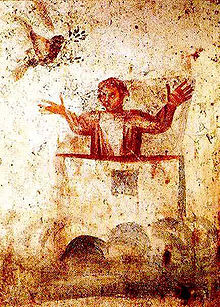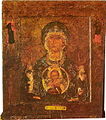Who Are the Figures Called Orants in Christian Art?

An early Christian painting of Noah in the gesture of orant

Orans (/ˈoː.rans/), a loanword from Medieval Latin ōrāns translated equally ane who is praying or pleading, also orant or orante, as well equally lifting up holy hands, is a posture or actual attitude of prayer, usually continuing, with the elbows shut to the sides of the body and with the hands outstretched sideways, palms up.[1] [2] [3] [4] The orans posture of prayer has a Scriptural footing in 1 Timothy two:8: "I desire, then, that in every place the men should pray, lifting up holy hands without acrimony or argument" (NRSV).[ane] [ii] [3] It was mutual in early on Christianity and can frequently be seen in early Christian art, being brash past several early Church Fathers, who saw it every bit "the outline of the cross".[1] [3] In modernistic times, the orans position is still preserved in Oriental Orthodoxy, every bit when Coptic Christian believers pray the seven canonical hours of the Agpeya at fixed prayer times;[5] the orans likewise occurs inside parts of the Catholic, Oriental Orthodox, Eastern Orthodox, Lutheran, Anglican and Latter-day Saint, liturgies, Pentecostal and charismatic worship, and the ascetical practices of some religious groups.[ii] [three]
History [edit]

The orans posture was adept past Jews before it was adopted past the early Christians.[half-dozen] The lifting upwards of holy hands is referenced in the Bible in Psalm 134:two–3, Psalm 28:2, Psalm 63:4–five, Psalm 141:2, Psalm 143:6, 1 Timothy 2:viii, and Hebrews 12:12–13.[7] [3] The biblical ordinance of lifting hands up in prayer was advised by many early Christian apologists, including Marcus Minucius Felix, Cloudless of Rome, Clement of Alexandria and Tertullian.[1] [ii] Christians saw the position as representing the posture of Christ on the Cross; therefore, it was the favorite of early Christians. Until the ninth century, the posture was sometimes adopted by entire congregations while celebrating the Eucharist.[8] [3] In Oriental Orthodoxy, Coptic Christian believers pray the seven approved hours of the Agpeya at fixed prayer times in the orans position while standing.[5] In Western Christianity, by the twelfth century, however, the joining of hands began to supplant the orans posture as the preferred position for prayer. The orans posture has connected to exist used at certain points in the liturgies of the Cosmic, Orthodox, Lutheran and Anglican Churches.[iii] During Mass in the Latin Rite of the Catholic Church, the celebrating priest prays the orations, the canon, and the Lord'southward Prayer in the gesture of orant; in the Maronite Rite of the Cosmic Church, the congregation together with the priest elevator upwards their hands in the orans posture during various parts of the litury, such equally the anaphora and the Our Father.[9] [three]
In the twentieth century, the orans posture experienced a revival equally a outcome of its widespread use within Pentecostalism and Charismatic Christianity. Oft associated with contemporary worship, the orans posture is one time again becoming a common gesture of worship among many Christian groups.[viii] [10] [11]
Depictions in fine art [edit]

Orans was mutual in early Sumerian cultures: "...it appears that Sumerian people might accept a statue carved to represent themselves and do their worshipping for them - in their place, as a stand in. An inscription on one such statue translates, 'Information technology offers prayers.' Some other inscription says, 'Statue, say unto my king (god)..."[12] The custom of praying in artifact with outstretched, raised artillery was common to both Jews and Gentiles, and indeed the iconographic type of the Orans was itself strongly influenced past classic representations. But the meaning of the orans of Christian art is quite different from that of its prototypes.[4]
Numerous Biblical figures, for instance, depicted in the catacombs of Rome — Noah, Abraham, Isaac, Shadrach, Meshach and Abednego, and Daniel in the panthera leo'south den — are pictured request the Lord to deliver the soul of the person on whose tombs they are depicted equally he once delivered the particular personage represented. Simply likewise these Biblical orans figures at that place exist in the catacombs many platonic figures (153 in all) in the aboriginal attitude of prayer,[four] representing the deceased's soul in heaven, praying for their friends on earth.[xiii]
One of the most convincing proofs that the orans was regarded as a symbol of the soul is an ancient lead medal in the Vatican Museum showing the martyr St. Lawrence, under torture, while his soul, in the class of a female orans, is merely leaving the body. An arcosolium in the Ostrianum cemetery represents an orans with a petition for her intercession: Victoriæ Virgini … Pete … The Acts of St. Cecilia speaks of souls leaving the trunk similar virgins: Vidit egredientes animas eorum de corporibus, quasi virgines de thalamo ("He saw their souls coming out of their bodies, like virgins from the chamber"), and then also the Acts of Sts. Peter and Marcellinus.[4]
Very probably the medieval representations of a diminutive trunk, figure of the soul, issuing from the mouths of the dying were reminiscences of the orans every bit a symbol of the soul. The before orantes were depicted in the simplest garb, and without any striking private traits, just in the 4th century the figures become richly adorned, and of marked individuality, an indication of the approach of celebrated art. One of the most remarkable figures of the orans cycle, dating from the early on fourth century, is interpreted by Wilpert as the Blest Virgin interceding for the friends of the deceased. Straight in front of Mary is a boy, non in the orans attitude and supposed to be the Divine Child, while to the right and left are monograms of Christ.[4]
The Platytéra, a hagiographic depiction on the Virgin Mary equally Our Lady of the Sign which is standing in the orans gesture, usually placed on the half-dome higher up the altar of Byzantine-way churches, and facing down the nave.
Some orans-type Eastern Orthodox icons of the Virgin Mary [edit]
-

Orans (catacombs of Rome), first half of IV c.
-

Orans in Kyiv Saint Sophia cathedral.
-

-

See likewise [edit]
- Panagia
- Worship
References [edit]
- ^ a b c d Couchman, Judith (five March 2010). The Mystery of the Cross: Bringing Ancient Christian Images to Life. InterVarsity Printing. p. 85. ISBN978-0-8308-7917-5.
Because early Christians were Jewish, they naturally lifted their hands in prayer, like the veiled orans figures in the catacombs. The campaigner Paul advised the earliest Christians, "I want men everywhere to lift up holy easily in prayer, without anger or disputing" (1 Tim 2:8) and early church literature indicates the widespread practice of this prayer position. In the get-go through third centuries, Marcus Minucius Felix, Cloudless of Rome, Clement of Alexandria and Tertullian either brash Christians to lift up easily in prayer, or at least mentioned the practice.
- ^ a b c d Wainwright, Geoffrey (1997). For Our Salvation: Two Approaches to the Work of Christ. Wm. B. Eerdmans Publishing. p. 76. ISBN978-0-8028-0846-2.
The piety shows itself in the informal signing of one's body with the sign of the cross, in what 1 Timothy two:8 calls "lifting holy easily" in prayer (a gesture stretching from the orans pictures in the catacombs to modernistic Pentecostalism), in penitential or submissive kneeling, in reverential genuflections, in the ascetical practices suggested by the campaigner Paul's athletic imagery (one Cor. ix:24-27; one Tim. half-dozen:6-16; 2 Tim. iv:7f).
- ^ a b c d e f g h "Why do we extend our artillery when praying the Our Father and at other times during the Maronite anaphora?". Living Maronite. Retrieved 24 April 2022.
This is sometimes referred to as the Orans posture. The posture is explicitly directed by the before long used Maronite Qorbono. The posture has in its origins an association with prayer. It can be found in the Old Testament. In Psalm 141 we pray: "Let my prayer exist counted as incense earlier you, and the lifting upwards of my easily as an evening sacrifice." The posture is referred to in the New Attestation at 1 Timothy ii:8, in the instructions apropos prayer: "I desire, and so, that in every identify the men should pray, lifting up holy easily without anger or argument;" We see the posture in the early Church catacomb icons as depicted here. The icon peradventure gives us the best indication of why the posture is before long used in the Maronite Mass.
- ^ a b c d east Herbermann, Charles, ed. (1913). . Catholic Encyclopedia. New York: Robert Appleton Company.
- ^ a b Dawood, Bishoy (eight Dec 2013). "Stand, Bow, Prostrate: The Prayerful Body of Coptic Christianity: Clarion Review". Clarion Review. Retrieved 27 July 2020.
Standing facing the East is the almost frequent prayer position. The person praying commonly holds his or her easily outwards in the 'orans' position, which is a common Christian position of prayer, frequently portrayed in ancient Christian art, including in Coptic iconography. At other times, hands may exist kept downward to the sides or held together equally a sign of standing in humility before God. Some people choose to concur a cross in their hands equally they stand in the orans position; in this case, the sign of the cross traced over the trunk ends with kissing the cross.
- ^ Emminghaus, Johannes H. (1997). The Eucharist: Essence, Class, Celebration. Liturgical Printing. p. 133. ISBN978-0-8146-1036-7.
This Jewish gesture of prayer was patently adopted by Christians for private equally well as communal prayer.
- ^ Byrum, Enoch Edwin (1904). "Ordinances of the Bible: Showing the Ordinances that Take Been Abolished, and Those Even so in Vogue". Gospel Trumpet Company. p. 114.
- ^ a b Stephen Burns, SCM Studyguide to Liturgy (Hymns Ancient & Mod Ltd, 2006), 62.
- ^ "Liturgical Gestures." New Catholic Encyclopedia. 2nd edition, volume eight. Detroit: Gale, 2003. 646-650. Gale Virtual Reference Library. Web. vii Feb 2012.
- ^ Paul Harvey and Philip Goff, The Columbia documentary history of religion in America since 1945 (Columbia University Printing, 2005), 347.
- ^ Larry Witham, Who shall lead them?: the future of ministry in America (Oxford Academy Press, i July 2005), 134.
- ^ Benton, DiYanni, J. R, R (2008). Arts and Civilization: An Introduction to the Humanities. Upper Saddle, New Jersey: Prentice Hall. p. 9. ISBN978-0-536-41910-ane.
- ^ Wilpert "Ein Cyklus christologischer Gemälde aus der Katakombe der Heiligen Petrus und Marcellinus" (Freiburg, 1891);
External links [edit]
- Including an orans mural from Lullingstone Roman Villa, now in the British Museum
- Why practise nosotros extend our arms when praying the Our Father and at other times during the Maronite anaphora?
![]() This article incorporates text from a publication now in the public domain:Herbermann, Charles, ed. (1913). "Orans". Catholic Encyclopedia. New York: Robert Appleton Company.
This article incorporates text from a publication now in the public domain:Herbermann, Charles, ed. (1913). "Orans". Catholic Encyclopedia. New York: Robert Appleton Company.
Source: https://en.wikipedia.org/wiki/Orans
Post a Comment for "Who Are the Figures Called Orants in Christian Art?"